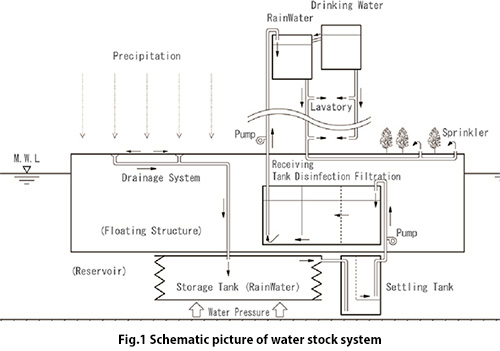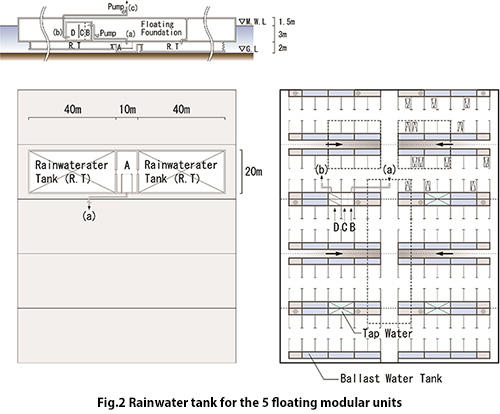
Ecological Aspects
1.General
Since rain that falls on the urban landscape is also an important natural resource, it is necessary to stock up on rainwater as much as possible. By facilitating the seepage underground of water that has once been stored, realization of a highly advanced society that circulates water by utilizing wells, etc. that can turn disaster conditions like flooding into a heaven-sent gift becomes possible. Therefore our concept suggests excavation of lower-lying land areas to realize a large reservoir in the middle of cities. Precipitation over an integrated reservoir is then used secondarily for human activities such as for flushing the lavatory, sprinkling the garden with water and so forth, as an additional source of water to supplement the existing drinking water and sewage systems in a city (See Fig. 1). Here, the utilization of floating foundations not only to make use of the open space atop artificial reservoirs for residential use but also to avoid evaporation resulting from exposure of the water surface is possible. With abundant water resources becoming available inside cities, there are many benefits. For example, it would be possible to install biotopes for the purpose of nurturing aquatic organisms like many types of animals including fish, plants and so on, thereby preserving the natural water environment and to contribute the bio-diversity in this area. The reservoir inside city improves the water cycle and creates a new water area environment with an earth-friendly, sustainable urban community.
2. On the water supply inside the water city of Koto Ward, Tokyo
The average precipitation amounts for Tokyo is about 1,340 mm per year. We consider to use rainwater as much as possible for the water city of Koto Ward, Tokyo. Moreover, with our proposal, we adopted the Grey Water Supply System which adds on an intermediate stage handling grey water, mainly centered upon rainwater, to the existing drinking and sewage systems. For the floating foundation consists of 5 modular units with 12,500 ㎡ surface area, a rainwater tank of 2,800 ? which is enough for maximum 250 mm/day precipitation recorded the heaviest precipitation in last 35 years is fixed underneath of the floating foundation (See Fig.2). The population on 5 modular units is some 450 people, and estimating that a single person using 300 l of water per day, the amount of water used by one unit's population per day is set at 135 t (or 2,138,400 t per year). As for the use of raw water for lavatories, baths and washings, the amount is set at 1,411,345 t per year (66% of total water use), with the balance of 727,055 t being used as part of the existing drinking water system. In addition, as is shown in Figs.1 and 2, the volume of the tank fixed underneath of the floating foundation inside of reservoir is designed to be enough for the total amount of precipitation of a whole year because lots of space is available inside the man-made lagoon and/or inlet. This additional rainwater tank need not to have costly structure like on land since water pressure between inside water pressure in tank and outside salt water pressure of man-made lagoon is almost in an equilibrium condition.
















